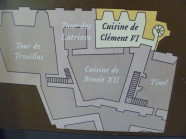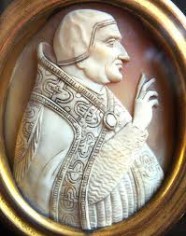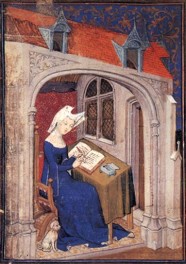Getting into the mind of a literary character is a gradual process, just as it is with real people. My biggest wow moment in my understanding of Solange Le Blanc in Muse came when I was on the secret tour of the popes’ palace in Avignon. I stared at the bare walls of a basement chamber trying to imagine the décor of the Pope’s bathing room as the guide was describing it. Then she led the way up a narrow corkscrew staircase—the only one that climbs six floors to the roof of the palace—and we emerged in the Pope’s bedchamber, with its decorated walls. Next to it was the even finer room where Pope Clement VI slept, with its magnificent frescoes of a stag hunt, hawking, fishing, gathering fruit, and the other secular pleasures of a seigneur. This room has always puzzled historians. Why did the Pope have such pagan art on his walls?
The main feature of the Stag Room was the Pope’s bed where, in medieval fashion, he sat to receive important guests. Although the bed is long gone, it was shorter than normal because he slept upright in case Christ arrived to claim him in the night. However, nothing else about this room was theological. Reports of luxurious bed hangings—crimson velvet and green taffeta—rival the tales of lavish banquets in the palace. The Avignon Pope lived more like a king than the spiritual leader of the Christian church.
I wondered what went on in this bedchamber in the 14th century. What would my character Solange have felt the first time she was brought here? I decided that a woman who had ascended so many stairs would realize that although the Pope was an immensely powerful man, he was also carnal and emotionally needy. Exhilarated by her own power over him, she would embrace the opportunity to become Pope Clement VI’s favourite, the most influential woman in Avignon.
This post first appeared at the Fiction Craft blog by Shaun Smith, at Open Book Ontario



